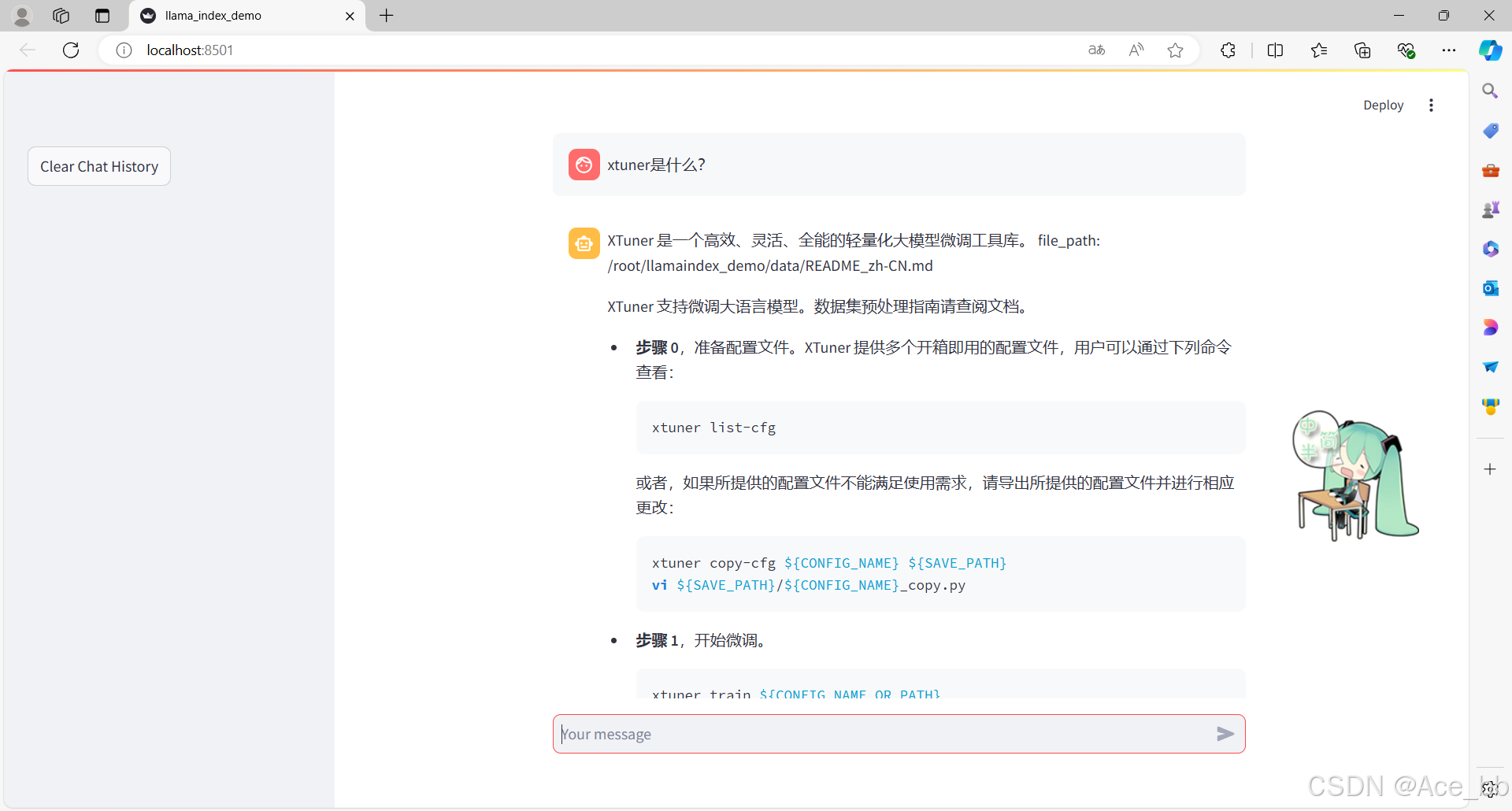文章目录
-
- [1. 前置知识](#1. 前置知识)
-
- RAG背景
- [RAG 效果比对](#RAG 效果比对)
- [2. 环境、模型准备](#2. 环境、模型准备)
-
- [2.1 配置基础环境](#2.1 配置基础环境)
- [2.2 安装 Python环境和依赖包](#2.2 安装 Python环境和依赖包)
- [2.3 下载 Sentence Transformer 模型](#2.3 下载 Sentence Transformer 模型)
- [2.4 下载 NLTK 相关资源](#2.4 下载 NLTK 相关资源)
- [3. LlamaIndex HuggingFaceLLM](#3. LlamaIndex HuggingFaceLLM)
- [4. LlamaIndex RAG](#4. LlamaIndex RAG)
- [5. LlamaIndex web](#5. LlamaIndex web)
本文将分为以下几个部分来介绍,如何使用 LlamaIndex 来部署 InternLM2 1.8B并实现RAG功能。
- 前置知识
- 环境、模型准备
- LlamaIndex HuggingFaceLLM
- LlamaIndex RAG
1. 前置知识
RAG背景
给模型注入新知识的方式,可以简单分为两种方式,一种是内部的,即更新模型的权重,另一个就是外部的方式,给模型注入格外的上下文或者说外部信息,不改变它的的权重。
第一种方式,改变了模型的权重即进行模型训练,这是一件代价比较大的事情,大语言模型具体的训练过程,可以参考InternLM2技术报告。第二种方式,并不改变模型的权重,只是给模型引入额外的信息。


对比两种注入知识方式,第二种更容易实现。RAG正是这种方式。它能够让基础模型实现非参数知识更新,无需训练就可以掌握新领域的知识。本次课程选用了LlamaIndex框架。LlamaIndex 是一个上下文增强的 LLM 框架,旨在通过将其与特定上下文数据集集成,增强大型语言模型(LLMs)的能力。它允许您构建应用程序,既利用 LLMs 的优势,又融入您的私有或领域特定信息。
在RAG中有五个关键阶段,这些阶段将成为你构建的任何更大应用程序的一部分。这些阶段包括:
-
加载:这指的是从数据源(无论是文本文件、PDF、另一个网站、数据库或API)获取你的数据并将其放入你的流水线中。LlamaHub 提供了数百个可供选择的连接器。
-
索引:这意味着创建一个允许查询数据的数据结构。对于LLM来说,这几乎总是意味着创建向量嵌入,即你的数据含义的数值表示,以及许多其他元数据策略,使其易于准确找到上下文相关的数据。
-
存储:一旦你的数据被索引,你几乎总是希望存储你的索引,以及其他元数据,以避免重新对其进行索引。
-
查询:对于任何给定的索引策略,你可以利用LLM和LlamaIndex数据结构进行查询的许多方式,包括子查询、多步查询和混合策略。
-
评估:在任何流水线中的一个关键步骤是检查它相对于其他策略的有效性,或者当你进行更改时。评估提供了关于你对查询的响应有多准确、忠实和快速的客观度量。
RAG 效果比对
如图所示,由于xtuner是一款比较新的框架, InternLM2-Chat-1.8B 训练数据库中并没有收录到它的相关信息。左图中问答均未给出准确的答案。右图未对 InternLM2-Chat-1.8B 进行任何增训的情况下,通过 RAG 技术实现的新增知识问答。

2. 环境、模型准备
2.1 配置基础环境
这里以在 Intern Studio 服务器上部署LlamaIndex为例。
进入开发机后,创建新的conda环境,命名为 llamaindex,在命令行模式下运行:
bash
conda create -n llamaindex python=3.10复制完成后,在本地查看环境。
bash
conda env list结果如下所示。
bash
# conda environments:
#
base * /root/.conda
llamaindex /root/.conda/envs/llamaindex运行 conda 命令,激活 llamaindex 然后安装相关基础依赖
python 虚拟环境:
bash
conda activate llamaindex
conda install pytorch==2.0.1 torchvision==0.15.2 torchaudio==2.0.2 pytorch-cuda=11.7 -c pytorch -c nvidia安装python 依赖包
bash
pip install einops
pip install protobuf环境激活。
2.2 安装 Python环境和依赖包
安装Python3.10版本的Anaconda虚拟环境和相关的包
bash
conda create -n llamaindex python=3.10
conda activate llamaindex
conda install pytorch==2.0.1 torchvision==0.15.2 torchaudio==2.0.2 pytorch-cuda=11.7 -c pytorch -c nvidia
pip install einops
pip install protobuf
pip install llama-index==0.10.38 llama-index-llms-huggingface==0.2.0 "transformers[torch]==4.41.1" "huggingface_hub[inference]==0.23.1" huggingface_hub==0.23.1 sentence-transformers==2.7.0 sentencepiece==0.2.02.3 下载 Sentence Transformer 模型
源词向量模型 Sentence Transformer:(我们也可以选用别的开源词向量模型来进行 Embedding,目前选用这个模型是相对轻量、支持中文且效果较好的,同学们可以自由尝试别的开源词向量模型)
运行以下指令,新建一个python文件,贴入以下代码
然后,执行该脚本即可自动开始下载:
bash
cd /root/llamaindex_demo
conda activate llamaindex
python download_hf.py更多关于镜像使用可以移步至 HF Mirror 查看。
2.4 下载 NLTK 相关资源
我们在使用开源词向量模型构建开源词向量的时候,需要用到第三方库 nltk 的一些资源。正常情况下,其会自动从互联网上下载,但可能由于网络原因会导致下载中断,此处我们可以从国内仓库镜像地址下载相关资源,保存到服务器上。
我们用以下命令下载 nltk 资源并解压到服务器上:
bash
cd /root
git clone https://gitee.com/yzy0612/nltk_data.git --branch gh-pages
cd nltk_data
mv packages/* ./
cd tokenizers
unzip punkt.zip
cd ../taggers
unzip averaged_perceptron_tagger.zip之后使用时服务器即会自动使用已有资源,无需再次下载
3. LlamaIndex HuggingFaceLLM
运行以下指令,把 InternLM2 1.8B 软连接出来
bash
cd ~/model
ln -s /root/share/new_models/Shanghai_AI_Laboratory/internlm2-chat-1_8b/ ./运行以下指令,新建一个python文件
bash
cd ~/llamaindex_demo
touch llamaindex_internlm.py打开llamaindex_internlm.py 贴入以下代码
python
from llama_index.llms.huggingface import HuggingFaceLLM
from llama_index.core.llms import ChatMessage
llm = HuggingFaceLLM(
model_name="/root/model/internlm2-chat-1_8b",
tokenizer_name="/root/model/internlm2-chat-1_8b",
model_kwargs={"trust_remote_code":True},
tokenizer_kwargs={"trust_remote_code":True}
)
rsp = llm.chat(messages=[ChatMessage(content="什么是丛集性头痛?")])
print(rsp)运行结果为:

回答的效果并不好,并不是我们想要的xtuner。
4. LlamaIndex RAG
安装 LlamaIndex 词嵌入向量依赖
bash
conda activate llamaindex
pip install llama-index-embeddings-huggingface llama-index-embeddings-instructor加载文档
LlamaIndex提供了两种方式创建文档,文档可以通过数据加载器自动创建,也可以手动构建。
默认情况下,我们所有的数据加载器(包括 LlamaHub 上提供的)都通过 load_data 函数返回 Document 对象。
详细使用方法建议看官方文档:http://www.aidoczh.com/llamaindex/module_guides/loading/documents_and_nodes/usage_documents/
python
from llama_index.core import SimpleDirectoryReader
documents = SimpleDirectoryReader("./data").load_data()您也可以选择手动构建文档。LlamaIndex 提供了 Document 结构。
python
from llama_index.core import Document
text_list = [text1, text2, ...]
documents = [Document(text=t) for t in text_list]数据加载器由LlamaHub提供,支持pdf, docs, pptx, epub等格式的数据。数据连接器使用指南建议看官方文档:
http://www.aidoczh.com/llamaindex/module_guides/loading/connector/。
部分如下:

这里使用的了丁香医生网站丛集性头痛内容作为知识库,原链接为:丛集性头痛
导出为markdown文件。然后在项目目录下创建data目录,将md文件存入data目录中。通过配置,LlamaIndex会自动加载这个目录中的文件存入知识库中。
bash
mkdir data
cd data构建向量存储索引库
建议阅读LlamaIndex官方文档介绍:http://www.aidoczh.com/llamaindex/module_guides/indexing/vector_store_index/
要构建向量索引库,首先需要完成第一步的加载文档。向量库可以接收SimpleDirectoryReader().load_data()返回的documents对象,构建成vector store,并提供相似度查询的接口。
使用 Vector Store 的最简单方法是使用 from_documents 加载一组文档并从中构建索引:
python
from llama_index.core import VectorStoreIndex, SimpleDirectoryReader
# 加载文档并构建索引
documents = SimpleDirectoryReader(
"../../examples/data/paul_graham"
).load_data()
index = VectorStoreIndex.from_documents(documents)VectorStoreIndex构建向量库时会自动对文档进行分片。
检索器
检索器定义了如何在给定查询时有效地从索引中检索相关上下文。检索策略对于检索到的数据的相关性和效率至关重要。检索器主要建立在向量库索引之上,被用作查询引擎,用于从向量库中检索出相关的上下文。
最简单的方式是使用向量索引库提供的默认检索器,也就是直接进行相似度检索。
python
retriever = index.as_retriever()
nodes = retriever.retrieve("Who is Paul Graham?")使用检索器检索到与用户query相关的结果之后,便可以将检索结果交给LLM来进行回答。
RAG代码
完整的RAG代码如下,包含了模型加载,文档加载,向量索引库构建,检索器构建和模型输出。
运行以下指令,新建一个python文件,打开llamaindex_RAG.py贴入以下代码
python
from llama_index.core import VectorStoreIndex, SimpleDirectoryReader, Settings
from llama_index.embeddings.huggingface import HuggingFaceEmbedding
from llama_index.llms.huggingface import HuggingFaceLLM
#初始化一个HuggingFaceEmbedding对象,用于将文本转换为向量表示
embed_model = HuggingFaceEmbedding(
#指定了一个预训练的sentence-transformer模型的路径
model_name="/root/model/sentence-transformer"
)
#将创建的嵌入模型赋值给全局设置的embed_model属性,
#这样在后续的索引构建过程中就会使用这个模型。
Settings.embed_model = embed_model
llm = HuggingFaceLLM(
model_name="/root/model/internlm2-chat-1_8b",
tokenizer_name="/root/model/internlm2-chat-1_8b",
model_kwargs={"trust_remote_code":True},
tokenizer_kwargs={"trust_remote_code":True}
)
#设置全局的llm属性,这样在索引查询时会使用这个模型。
Settings.llm = llm
#从指定目录读取所有文档,并加载数据到内存中
documents = SimpleDirectoryReader("/root/Demo/LlamaIndex/data").load_data()
#创建一个VectorStoreIndex,并使用之前加载的文档来构建索引。
# 此索引将文档转换为向量,并存储这些向量以便于快速检索。
index = VectorStoreIndex.from_documents(documents)
# 创建一个查询引擎,这个引擎可以接收查询并返回相关文档的响应。
query_engine = index.as_query_engine()
response = query_engine.query("什么是丛集性头痛?")
print(response)运行结果为:

借助RAG技术后,就能获得我们想要的答案了。可以看到回答得比没有加RAG要好很多。
5. LlamaIndex web
运行之前首先安装依赖
shell
pip install streamlit==1.36.0运行以下指令,新建一个python文件
bash
cd ~/llamaindex_demo
touch app.py打开app.py贴入以下代码
python
import streamlit as st
from llama_index.core import VectorStoreIndex, SimpleDirectoryReader, Settings
from llama_index.embeddings.huggingface import HuggingFaceEmbedding
from llama_index.llms.huggingface import HuggingFaceLLM
st.set_page_config(page_title="llama_index_demo", page_icon="🦜🔗")
st.title("llama_index_demo")
# 初始化模型
@st.cache_resource
def init_models():
embed_model = HuggingFaceEmbedding(
model_name="/root/model/sentence-transformer"
)
Settings.embed_model = embed_model
llm = HuggingFaceLLM(
model_name="/root/model/internlm2-chat-1_8b",
tokenizer_name="/root/model/internlm2-chat-1_8b",
model_kwargs={"trust_remote_code": True},
tokenizer_kwargs={"trust_remote_code": True}
)
Settings.llm = llm
documents = SimpleDirectoryReader("/root/llamaindex_demo/data").load_data()
index = VectorStoreIndex.from_documents(documents)
query_engine = index.as_query_engine()
return query_engine
# 检查是否需要初始化模型
if 'query_engine' not in st.session_state:
st.session_state['query_engine'] = init_models()
def greet2(question):
response = st.session_state['query_engine'].query(question)
return response
# Store LLM generated responses
if "messages" not in st.session_state.keys():
st.session_state.messages = [{"role": "assistant", "content": "你好,我是你的助手,有什么我可以帮助你的吗?"}]
# Display or clear chat messages
for message in st.session_state.messages:
with st.chat_message(message["role"]):
st.write(message["content"])
def clear_chat_history():
st.session_state.messages = [{"role": "assistant", "content": "你好,我是你的助手,有什么我可以帮助你的吗?"}]
st.sidebar.button('Clear Chat History', on_click=clear_chat_history)
# Function for generating LLaMA2 response
def generate_llama_index_response(prompt_input):
return greet2(prompt_input)
# User-provided prompt
if prompt := st.chat_input():
st.session_state.messages.append({"role": "user", "content": prompt})
with st.chat_message("user"):
st.write(prompt)
# Gegenerate_llama_index_response last message is not from assistant
if st.session_state.messages[-1]["role"] != "assistant":
with st.chat_message("assistant"):
with st.spinner("Thinking..."):
response = generate_llama_index_response(prompt)
placeholder = st.empty()
placeholder.markdown(response)
message = {"role": "assistant", "content": response}
st.session_state.messages.append(message)之后运行
bash
streamlit run app.py然后在命令行点击,红框里的url。
即可进入以下网页,然后就可以开始尝试问问题了。
询问结果为:
